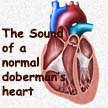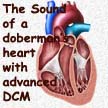Dilated Cardiomyopathy – Heart Failure In Your Dog
(DCM)
Ron Hines DVM PhD



Diet-Related Cardiomyopathy?
With the introduction of “grain-free” and boutique brands of dog food with eye-catching graphics to please you, but with little or no understanding of the nutritional needs of dogs, a new form of heart disease, dilated cardiomyopathy, is on the rise. Originally, veterinarians at the Tufts/Cummings veterinary school and the FDA were unsure if those diets lacked some vital nutrient(s) or if they contained heart-toxic ingredient(s), or both. (read here) The problem began when pet food companies, following popular human eating trends, began substituting legumes (=beans, peas, chickpeas, soybeans, etc.) for the carbohydrates in the grains that they were traditionally using in dog food manufacturing (= corn, rice, oats, barley and wheat). The starch in all of these diets is needed to bind their dry kibble products together in the baking process and in both dry and canned foods, to keep production costs down. Quality meat is expensive. Current suspicions are that high legume-content grain-free diets somehow block the absorption of nutrients that are vital to a dog’s heart. (read here & here) However, we also know that not every case of cardiomyopathy is related to your dog’s diet.
In large dogs, younger than 10 yrs of age, dilated cardiomyopathy (DCM) is the most common cause of heart disease leading to death. In the general dog population, DCM ranks only behind mitral valve heart disease and congestive heart failure (CHF) as an eventual cause of death. The diagnosis of dilated cardiomyopathy puts enormous emotional strain on a dog owners. Unlike congestive heart failure (CHF), for which your veterinarian has many medical treatment options, veterinarians will inform you that they have very limited ways to buy more time when DCM is your dog’s problem. Costly open-heart surgery is sometimes an option for heart valve problems in dogs. (read here), But there is no surgical option for dogs with cardiomyopathy. Conveying that news is one of the hardest parts of being a veterinarian. You can read how that grief affects us all here.
What Is Occurring In My Dog’s Heart?
When your dog develops dilated cardiomyopathy, changes are occurring in the specialized cardiac muscles composing its heart that decrease the organ’s ability to forcefully contract. Although those destructive changes are usually present in all four of your dog’s heart chambers, they are usually most severe in the lower left chamber, the left ventricle. That chamber is the most muscular of the four because its job is to force blood throughout your dog’s entire circulatory system of arteries and veins. Its right chambers service only its lungs. When your dog’s left ventricle can no longer do that efficiently, its body starves for oxygen (hypoxia). Sluggishly-flowing blood pools (= congestion, edema) in your pet’s lungs and various other organs as well as its body cavities (e.g. ascites, pulmonary edema). As the dog’s heart struggles to meet its body’s circulatory needs, the heart’s walls become thinner and its heart’s size enlarges (=dilation). The heart assumes a more rounded (globular) shape. As its heart geometry deforms, its heart electrical system begins to cease functioning normally.
Are Certain Dog Breeds More Susceptible To DCM Than Others?
Yes.
Your dog’s genetics are thought to account for a great deal of its susceptibility to dilated cardiomyopathy. I already mentioned that the larger dog breeds face DCM considerably more frequently than the smaller dog breeds. But even large breeds do not suffer the problem with equal frequency. Of the 11 breeds most likely to develop DCM in one study, Great Danes, St. Bernards, Newfoundlands, Leonbergers, Dobermans, Finnish hounds, Boxers, Giant Schnauzers, English cocker spaniels, and Flat-coated retrievers led the list in DCM frequency in that order. Other studies put Irish Wolfhounds at the top of the list. Dogs are usually, but not always, middle-aged when conspicuous signs of their disease first appear. In the same first-mentioned study, the survival time for dogs after the disease was diagnosed was 27-140 days. I will send you that study if you request Haggstrom2008.pdf. Even within those higher-risk breeds, some families, breeding kennels and genetic lines are considerably more likely to develop dilated cardiomyopathy than others. It is only when the gene pool (diversity) of a dog breed is dangerously small (too few originating dogs or “progenitors”) that the whole breed tends to suffer equally. That seems to be the case in Irish Wolfhounds. (read here) According to Purdue University Veterinary School statistics, the prevalence of DCM in male dogs examined in their clinic was nearly twice that of females (0.66% vs 0.34%). Veterinarians do not know why, but in humans a protective effect of female hormones is suspected. (read here)
If My Dog Develops Dilated Cardiomyopathy, What Signs Might I See?
Dogs who are genetically predestined to develop DCM probably have destructive changes occurring in their hearts at an early age. However, your regular hospital veterinarian is unlikely to detect them. A specialist veterinary cardiologist might notice early irregularities in your pet’s EKG even before symptoms become apparent. The heart is a powerful organ created with a large reserve of muscle cells. For many years, it can compensate for the loss of a moderate amount of individual heart muscle fibers. The first signs many dog owners describe is a decrease in their pet’s activity level. Their dogs don’t have the willingness or ability to exercise as much as they once did. That is because their hearts can no longer meet the increased oxygen needs of strenuous exercise. Some lose weight due to a decreased interest in food. Others develop a soft cough. In breeds with a high incidence of DCM, even subtle signs might prompt your veterinarian to have some electrocardiogram tests run – perhaps with the aid of a Holter halter. But in most cases, early signs of DCM are overlooked, and it is not until signs attributable to actual heart failure occur that these dogs are brought to their veterinarians for consultation. The signs then often include coughing, a rapid irregular and weak pulse, rapid and difficult breathing (dyspnea), low oxygen saturation, more pronounced weight loss, and sometimes, fluid accumulation in the pet’s abdomen (ascites). Other dogs experience fainting spells due to disturbances in their heart’s electrical system. The gums of these dogs are often pale, occasionally slightly bluish and the tiny blood vessels at the gums’ surface are more prominent (injected) than normal. Lat in the disease, their heart beat can often be detected in their jugular vein (a jugular pulse). (read here) Some breeds, such as standard schnauzers with DCM, tend to go on to heart failure at an earlier age (~1.6 years) – particularly when they are males. Sometimes the progress of DCM is rapid enough for a dog to die from an irregular heart beat before it was even noticed that it was ill.
What Tests Will My Veterinarian Run?
Your veterinarian will probably quickly zero in on your dog’s heart as it’s probable problem. But there are a number of other heart problems that produce the same or similar clinical signs that need to be ruled out. As I mentioned, all forms of heart disease produce quite similar symptoms; and other problems such as pneumonia, chest tumors, toxin ingestion, heart developmental defects and autoimmune disease can produce similar heart-related symptoms too. I live in South Texas where Chagas disease in dogs mimics DCM. (read here) Chagas disease and the kissing bug parasites that spread it are slowing moving northward into the United States. (read here) Here in Texas, heartworms are still the most common cause of heart failure.
Once DCM has progressed to heart enlargement, ordinary x-rays of your dog’s chest will confirm that. X-rays will also help rule out some of the other possible causes of difficult respiration that I mentioned earlier. An irregular pulse and/or heart murmurs detected with a simple stethoscope in non-anemic dogs also help confirm heart involvement. If there is doubt about that, the proBNP test might be ordered as well. At that point, your veterinarian will probably inform you that only a board certified veterinary cardiologist has the specialized training and equipment required to delve deeper into your pet’s heart problem. The cardiologist’s primary tool is doppler ultrasound (echocardiography) that examines the thickness of your dog’s heart chambers, condition of its heart valves, and abnormalities in the flow of blood through the heart. (read here) Their interpretation of EKG results might be more detailed, and they might also have more experience utilizing some of the specialized medication cocktails in ways more likely to minimize side effects. Rhythm defects are one of the main things cardiologists look for (e.g. atrial fibrillation, supra-ventricular tachycardia ventricular premature complexes and ventricular tachycardia). All predispose a dog to sudden death. That is not to say that veterinary cardiologists have many more helpful medications than your primary care veterinarian does. What I would suggest is that your primary care veterinarian schedule an Idexx telemedicine consultation.
Your veterinarian and/or the cardiologist might suggest some genetic tests as well in order to determine if your dog carries gene combinations that predispose it to DCM – particularly if you are selecting the dog for breeding or as a service dog. Perhaps tests that detect telltale compounds an inapparent, but damaged heart might release (such as proBNP or natriuretic peptide) would be in order too. Most of these tests are still in their developmental stage. (read here) Tests that detect hypothyroidism might be indicated as well. But blood serum chemistry and urine tests do not provide much insight into organic heart problems. Your veterinarian may want to run them just to be sure there are no coexisting liver, kidney or other problems that might affect the action of the heart medications he or she will dispense.
Nutrition
Veterinarians have known for a long time that a sulfo-amino acid, taurine, deficiency can be responsible for dilated cardiomyopathy in cats. (read here) Human grade turkey and chicken are particularly rich in taurine, as are shellfish. In dogs, a carnitine deficiency was once implicated in heart failure as well. (read here) But more recent studies have not confirmed that. With time, the prevalence of DCM in cats decreased as pet food manufacturers made sure that their diets contained sufficient amounts of artificial taurine (good human-quality poultry, beef and other meats rich in taurine are expensive, so manufacturers of pet foods tend to scrimp and add meat sources of low quality, considered inedible or close to inedible for humans). Cases of taurine deficiency-induced DCM have also been reported in dogs – particularly golden retrievers. (read here)
As I mentioned earlier, the incidence of DCM in which diet is suspected to play a part has been creeping up in dogs. That increase has paralleled the trend to feeding our dogs diets that are grain-free, gluten-free or contain exotic ingredients whose long-term effects on canine health is unknown. They are often among the “boutique premium brands” with trendy ingredients. There is more profit in selling these products than in selling traditional dog food, so many small companies manufacture them and sell them through groomers, pet superstores, the internet and the like. But these smaller companies rarely have veterinary nutritionists on staff or the resources for sophisticated nutritional analysis. Now, even the larger dog food manufacturers see big financial opportunities in providing these untested products.
It may not be that these newer boutique dog foods are deficient in taurine per se. But their formulas – especially the ones that advertise as “grain-free” – might in some way decrease taurine absorption. Many of these diets claim to meet the canine nutritional standards of the AFIA, an animal feed trade association or the AAFCO. But few, if any, were ever tested in dog feeding trials that observed for increased later heart or other disease issues. Your veterinarian might suggest a blood taurine level assay. But taurine supplementation – even when low taurine levels are found – does not necessarily reverse the damage that DCM has already caused.
What Are My Dog’s Treatment Options?
The best veterinarians have to offer your dog are medications that improve the remaining abilities of its heart to pump blood. Those are the same drugs that veterinarians use to treat all forms of heart failure in dogs. They are also the same medicines that human cardiologists prescribe for failing hearts. Those medications include ACE inhibitors like enalapril (Enacard®) or benazepril (Lotensin®, etc.) to lower resistance to blood flow. They also include pimobendan (Vetmedin®) to strengthen the force of each heart contraction. When your dog’s heart is no longer pumping forcefully enough to keep fluids from pooling in its lungs and abdomen, furosemide (Lasix®), a diuretic, is usually dispensed. One of these heart drugs, pimobendan, appears to gain more time for your dog when DCM is discovered early. More exotic medications like carvedilol (Coreg®) and metoprolol (Lopressor®) and drugs given in an attempt to correct heart rhythm abnormalities such as mexiletine, atenolol and sotalol are sometimes dispensed by veterinary cardiologists as well. When furosemide is no longer sufficient to control pooled fluids in your dog’s lungs or abdomen, other diuretics such as spironolactone or hydrochlorothiazide can be added as well. Some veterinarians dispense l-carnitine, taurine, omega-3 and Coenzyme Q supplements. But none have been proven to be of help other than those containing taurine when blood taurine levels were confirmed to be low. Both Hills and Purina make low-sodium dog foods. But none have been confirmed to extend the lives of dogs with DCM.
What Is The Outlook For My Dog?
That varies from case to case, but the end result is never favorable. Some breeds, like dobermans tend to go down hill rapidly – even with medications. Others, like cocker spaniels often go down hill slower. The outlook for dogs improves slightly when their heart is enlarged but no electrical (rhythm) abnormalities are detected. The only cases of DCM that have occasionally been reversed or halted are those that were due to a taurine deficiency that was then corrected. Very few dogs survive more than 6 months to 1.5 years after a diagnosis of DCM has been made.
Can You Predict Which Dogs Will Develop DCM When Purchasing A Puppy Or Selecting A Breeding Dog?
When contemplating the purchase of a high DCM risk breed, exhaustive research into the dog’s parents and their prior litters for evidence of increased susceptibility (family history) to DCM is very important. Some breeders go so far as to schedule yearly echocardiogram and Holter monitor screening of their breeding dogs to reassure purchasers of their puppies. Prospective dog owners need to be certain that the family line from which their dog is selected was not prone to early death – regardless of the reported diagnosis. That is the sort of information that some breeders are very reluctant to release. There has been some progress in finding genes that are associated with doberman pinchers developing cardiomyopathy later in life. (read here) The problem is that some dogs that carry these gene combinations will never develop heart disease (= incomplete or variable gene penetrance), while others that appear free of those genes still go on to develop cardiomyopathy (DCM). Others are looking for blood tests that might be specific for compounds released early in dilated cardiomyopathy disease. (read here) Genetic tests for DCM in specific breeds are also available. (see here)
You are on the Vetspace animal health website
Visiting the products that you see displayed on this website help pay the cost of keeping these articles on the Internet.





